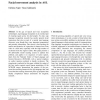Free Online Productivity Tools
i2Speak
i2Symbol
i2OCR
iTex2Img
iWeb2Print
iWeb2Shot
i2Type
iPdf2Split
iPdf2Merge
i2Bopomofo
i2Arabic
i2Style
i2Image
i2PDF
iLatex2Rtf
Sci2ools
UAIS
2008
2008
Facial movement analysis in ASL
In the age of speech and voice recognition technologies, sign language recognition is an essential part of ensuring equal access for deaf people. To date, sign language recognition research has mostly ignored facial expressions that arise as part of a natural sign language discourse, even though they carry important grammatical and prosodic information. One reason is that tracking the motion and dynamics of expressions in human faces from video is a hard task, especially with the high number of occlusions from the signers' hands. This paper presents a 3D deformable model tracking system to address this problem, and applies it to sequences of native signers, taken from the National Center of Sign Language and Gesture Resources (NCSLGR), with a special emphasis on outlier rejection methods to handle occlusions. The experiments conducted in this paper validate the output of the face tracker against expert human annotations of the NCSLGR corpus, demonstrate the promise of the proposed...
| Added | 16 Dec 2010 |
| Updated | 16 Dec 2010 |
| Type | Journal |
| Year | 2008 |
| Where | UAIS |
| Authors | Christian Vogler, Siome Goldenstein |
Comments (0)

